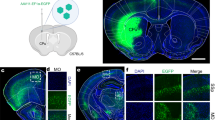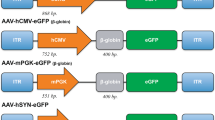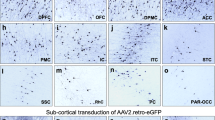Abstract
We have previously shown that adeno-associated virus type 2 (AAV2) undergoes anterograde axonal transport in rat and non-human primate brain. We screened other AAV serotypes for axonal transport and found that AAV6 is transported almost exclusively in a retrograde direction and, in the same way as AAV2, it is also neuron-specific in rat brain. Our findings show that axonal transport of AAV is serotype dependent and this has implications for gene therapy of neurological diseases such as Huntington's disease.
This is a preview of subscription content, access via your institution
Access options
Subscribe to this journal
Receive 12 print issues and online access
$259.00 per year
only $21.58 per issue
Buy this article
- Purchase on Springer Link
- Instant access to full article PDF
Prices may be subject to local taxes which are calculated during checkout






Similar content being viewed by others
References
Ciesielska A, Mittermeyer G, Hadaczek P, Kells AP, Forsayeth J, Bankiewicz KS . Anterograde axonal transport of AAV2-GDNF in rat basal ganglia. Mol Ther 2011; 19: 922–927.
Kells AP, Hadaczek P, Yin D, Bringas J, Varenika V, Forsayeth J et al. Efficient gene therapy-based method for the delivery of therapeutics to primate cortex. Proc Natl Acad Sci USA 2009; 106: 2407–2411.
Kaspar BK, Llado J, Sherkat N, Rothstein JD, Gage FH . Retrograde viral delivery of IGF-1 prolongs survival in a mouse ALS model. Science 2003; 301: 839–842.
Hadaczek P, Forsayeth J, Mirek H, Munson K, Bringas J, Pivirotto P et al. Transduction of nonhuman primate brain with adeno-associated virus serotype 1: vector trafficking and immune response. Hum Gene Ther 2009; 20: 225–237.
Daadi MM, Pivirotto P, Bringas J, Cunningham J, Forsayeth J, Eberling J et al. Distribution of AAV2-hAADC-transduced cells after 3 years in Parkinsonian monkeys. Neuroreport 2006; 17: 201–204.
Kha HT, Finkelstein DI, Tomas D, Drago J, Pow DV, Horne MK . Projections from the substantia nigra pars reticulata to the motor thalamus of the rat: single axon reconstructions and immunohistochemical study. J Comp Neurol 2001; 440: 20–30.
Thomas CE, Storm TA, Huang Z, Kay MA . Rapid uncoating of vector genomes is the key to efficient liver transduction with pseudotyped adeno-associated virus vectors. J Virol 2004; 78: 3110–3122.
Frampton Jr AR, Goins WF, Nakano K, Burton EA, Glorioso JC . HSV trafficking and development of gene therapy vectors with applications in the nervous system. Gene Therapy 2005; 12: 891–901.
McGraw HM, Awasthi S, Wojcechowskyj JA, Friedman HM . Anterograde spread of herpes simplex virus type 1 requires glycoprotein E and glycoprotein I but not Us9. J Virol 2009; 83: 8315–8326.
Kuo H, Ingram DK, Crystal RG, Mastrangeli A . Retrograde transfer of replication deficient recombinant adenovirus vector in the central nervous system for tracing studies. Brain Res 1995; 705: 31–38.
Diefenbach RJ, Miranda-Saksena M, Douglas MW, Cunningham AL . Transport and egress of herpes simplex virus in neurons. Rev Med Virol 2008; 18: 35–51.
Gao G, Vandenberghe LH, Alvira MR, Lu Y, Calcedo R, Zhou X et al. Clades of Adeno-associated viruses are widely disseminated in human tissues. J Virol 2004; 78: 6381–6388.
Burger C, Gorbatyuk O, Velardo M, Peden C, Williams P, Zolotukhin S et al. Recombinant AAV viral vectors pseudotyped with viral capsids from serotypes 1, 2 and 5 display differential efficiency and cell tropism after delivery to different regions of the central nervous system. Mol Ther 2004; 10: 302–317.
Choi VW, McCarty DM, Samulski RJ . AAV hybrid serotypes: improved vectors for gene delivery. Curr Gene Ther 2005; 5: 299–310.
Fitzsimons HL, Bland RJ, During MJ . Promoters and regulatory elements that improve adeno-associated virus transgene expression in the brain. Methods 2002; 28: 227–236.
Green AP, Huang JJ, Scott MO, Kierstead TD, Beaupre I, Gao GP et al. A new scalable method for the purification of recombinant adenovirus vectors. Hum Gene Ther 2002; 13: 1921–1934.
Klein RL, Dayton RD, Tatom JB, Henderson KM, Henning PP . AAV8, 9, Rh10, Rh43 vector gene transfer in the rat brain: effects of serotype, promoter and purification method. Mol Ther 2008; 16: 89–96.
Berardelli A, Noth J, Thompson PD, Bollen EL, Curra A, Deuschl G et al. Pathophysiology of chorea and bradykinesia in Huntington's disease. Mov Disord 1999; 14: 398–403.
Richardson RM, Kells AP, Rosenbluth KH, Salegio EA, Fiandaca MS, Larson PS et al. Interventional MRI-guided putaminal delivery of AAV2-GDNF for a planned clinical trial in Parkinson's disease. Mol Ther 2011; 19: 1048–1057.
Acknowledgements
This work was supported by NIH grant R01NS073940 to KSB.
Author information
Authors and Affiliations
Corresponding author
Ethics declarations
Competing interests
The authors declare no conflict of interest.
Additional information
Supplementary Information accompanies the paper on Gene Therapy website
Rights and permissions
About this article
Cite this article
Salegio, E., Samaranch, L., Kells, A. et al. Axonal transport of adeno-associated viral vectors is serotype-dependent. Gene Ther 20, 348–352 (2013). https://doi.org/10.1038/gt.2012.27
Received:
Revised:
Accepted:
Published:
Issue Date:
DOI: https://doi.org/10.1038/gt.2012.27
Keywords
This article is cited by
-
Brain-wide TVA compensation allows rabies virus to retrograde target cell-type-specific projection neurons
Molecular Brain (2022)
-
Dorsal striatal dopamine induces fronto-cortical hypoactivity and attenuates anxiety and compulsive behaviors in rats
Neuropsychopharmacology (2022)
-
Role of neuropeptide neuromedin U in the nucleus accumbens shell in cocaine self-administration in male rats
Neuropsychopharmacology (2022)
-
A Systematic Review of Direct Outputs from the Cerebellum to the Brainstem and Diencephalon in Mammals
The Cerebellum (2022)
-
Viral Tools for Neural Circuit Tracing
Neuroscience Bulletin (2022)



